Compact Tri-Band Bandpass Filter with Wide Upper Stopband Based on Spoof Surface Plasmon Polaritons and Open-/Short-Circuited Stubs
Abstract
:1. Introduction
2. Analysis of New SSPP Unit
3. Design of Wide-Stopband Tri-Band BPF
3.1. Wide-Stopband Bandpass Filter
- The upper and lower cutoff frequencies are the key points of the SSPP-based bandpass filter. The upper cutoff frequency of the bandpass filter is determined by the height (h) and depth of the slots (s) and the period (p) of the U-shaped ring SSPP cell. Generally, the period (p) is determined first, and then the height (h) of the U-shaped ring SSPP cell and the depth (s) of the slot are ascertained with the help of the dispersion curves. On the other hand, the lower cutoff frequency of the bandpass filter is controlled by the SCSs, mainly by using its resonance at 1/4λ, which produces similar high-pass characteristics. So, the lower cutoff frequency of the bandpass filter can be adjusted by changing the length of the SCSs.
- Utilizing the proposed U-shaped ring SSPP units and the SSPPs-SCSs integrated configuration, a BPF featuring a wide stopband has been designed for demonstration purposes. Figure 4 illustrates the schematic diagram of this BPF. This design includes the following components:
- Region 1 consists of a microstrip line feeding section with a characteristic impedance of 50 Ω.
- Region 2 includes a transition section with gradient-height U-shaped ring SSPP units.
- Region 3 is made up of a transmission section that employs an SSPPs-SCSs integrated configuration. Four SCSs were placed equally spaced in the middle of the SSPP unit. Because the SCSs are placed between the SSPP cells, the size of the whole filter structure does not increase much.

3.2. Wide-Stopband Tri-Band Bandpass Filter
4. Experimental Validation
5. Conclusions
Author Contributions
Funding
Data Availability Statement
Conflicts of Interest
References
- Barnes, W.L.; Dereux, A.; Ebbesen, T.W. Surface plasmon subwavelength optics. Nature 2003, 424, 824–830. [Google Scholar] [CrossRef] [PubMed]
- Pitarke, J.M.; Silkin, V.M.; Chulkov, E.V.; Echenique, P.M. Theory of surface plasmons and surface-plasmon polaritons. Rep. Prog. Phys. 2007, 70, 1–87. [Google Scholar] [CrossRef]
- Ozbay, E. Plasmonics: Merging photonics and electronics at nanoscale dimensions. Science 2006, 311, 189–193. [Google Scholar] [CrossRef] [PubMed]
- Gramotnev, D.K.; Bozhevolnyi, S.I. Plasmonics beyond the diffraction limit. Nat. Photonics 2010, 4, 83–91. [Google Scholar] [CrossRef]
- Pendry, J.B.; Martin-Moreno, L.; Garcia-Vidal, F.J. Mimicking surface plasmons with structured surfaces. Science 2004, 305, 847–848. [Google Scholar] [CrossRef] [PubMed]
- Williams, C.R.; Andrews, S.R.; Maier, S.A.; Fernandez-Dominguez, A.I.; Martin-Moreno, L.; Garcia-Vidal, F.J. Highly confined guiding of terahertz surface plasmon polaritons on structured metal surfaces. Nat. Photonics 2008, 2, 175–179. [Google Scholar] [CrossRef]
- Chen, J.-X.; Cao, S.-H.; Zhang, X.-F. SPPs-Shared Dual-Band Antenna With Large Frequency Ratio. IEEE Access 2020, 8, 29132–29139. [Google Scholar] [CrossRef]
- Zhang, D.; Zhang, K.; Wu, Q.; Yang, G.; Sha, X. High-efficiency broadband excitation and propagation of second-mode spoof surface plasmon polaritons by a complementary structure. Opt. Lett. 2017, 42, 2766–2769. [Google Scholar] [CrossRef]
- Zhang, X.-F.; Cao, S.-H.; Chen, J.-X. Novel millimeter-wave bandwidth-controllable filtering antenna based on composite ESPPs-SIW structure. IEEE Trans. Antennas Propag. 2021, 69, 7924–7929. [Google Scholar] [CrossRef]
- Chen, J.-X.; Zhu, P.-X.; Shi, X. A compact low-loss bandpass filter using spoof surface plasmon polaritons in a ridge waveguide. IEEE Microw. Wirel. Technol. Lett. 2024, 34, 1151–1154. [Google Scholar] [CrossRef]
- Zhang, X.; Fan, J.; Chen, J. Bandwidth-controllable band-stop filter using spoof surface plasmon polaritons. Int. J. RF Microw. Comput.-Aided Eng. 2020, 30, e21293. [Google Scholar] [CrossRef]
- Pan, B.C.; Yu, P.; Liao, Z.; Zhu, F.; Luo, G.Q. A compact filtering power divider based on spoof surface plasmon polaritons and substrate integrated waveguide. IEEE Microw. Wireless Compon. Lett. 2022, 32, 101–104. [Google Scholar] [CrossRef]
- Feng, Y.N.; Xu, K.D.; Niu, Z.Q.; Liu, L.J.; Zhang, B.; Fan, Y. WR-4 band wideband waveguide diplexer based on spoof surface plasmon polaritons and its application in terahertz communications. IEEE Trans. Microw. Theory Tech. 2024, 72, 4779–4789. [Google Scholar] [CrossRef]
- Zhang, X.; Fan, J.; Chen, J.X. High Gain and High-Efficiency Millimeter-Wave Antenna Based on Spoof Surface Plasmon Polaritons. IEEE Trans. Antennas Propag. 2019, 67, 687–691. [Google Scholar] [CrossRef]
- Pham, D.A.; Lee, M.; Sarkar, A.; Lim, S. High-Gain Elevational-Scanning Multibeam Planar SSPP Antenna Array with Large Ground-Clearance for Millimeter-Wave UAM Applications. IEEE Trans. Veh. Technol. 2024, 73, 5139–5149. [Google Scholar] [CrossRef]
- Zhao, H.X.; Zhou, P.; Xu, Z.X.; Li, S.L.; Yang, M.; Liu, L.L.; Yin, X.X. Tri-Band Band-Pass Filter Based on Multi-Mode Spoof Surface Plasmon Polaritons. IEEE Access 2020, 8, 14767–14776. [Google Scholar] [CrossRef]
- Ye, L.F.; Chen, Z.K.; Zhang, Y.; Li, W.W.; Zhang, Y.; Wei, K.L. High Performance Multiple Passband Substrate Integrated Plasmonic Filters. IEEE Trans. Circuits Syst. II Exp. Briefs. 2023, 70, 1445–1449. [Google Scholar] [CrossRef]
- Yang, S.Y.; Liu, S.; He, F.C.; Zhu, H.L.; Wang, L.J.; Lei, D.; Gao, C.; Yang, J.; Liu, S. Compact Muti-Frequency Band-Pass Filters Based on High-Order Mode of Folded Line Spoof Surface Plasmon Polaritons Waveguide. IEEE Access 2024, 12, 7244–7254. [Google Scholar] [CrossRef]
- Ren, B.P.; Chen, W.J.; Guan, X.H.; Wan, S.P. Compact bandpass filter with ultra-wide stopband based on spoof surface plasmon polaritons for sub-6G application. AEU Int. J. Electron. Commun. 2024, 176, 155152. [Google Scholar] [CrossRef]

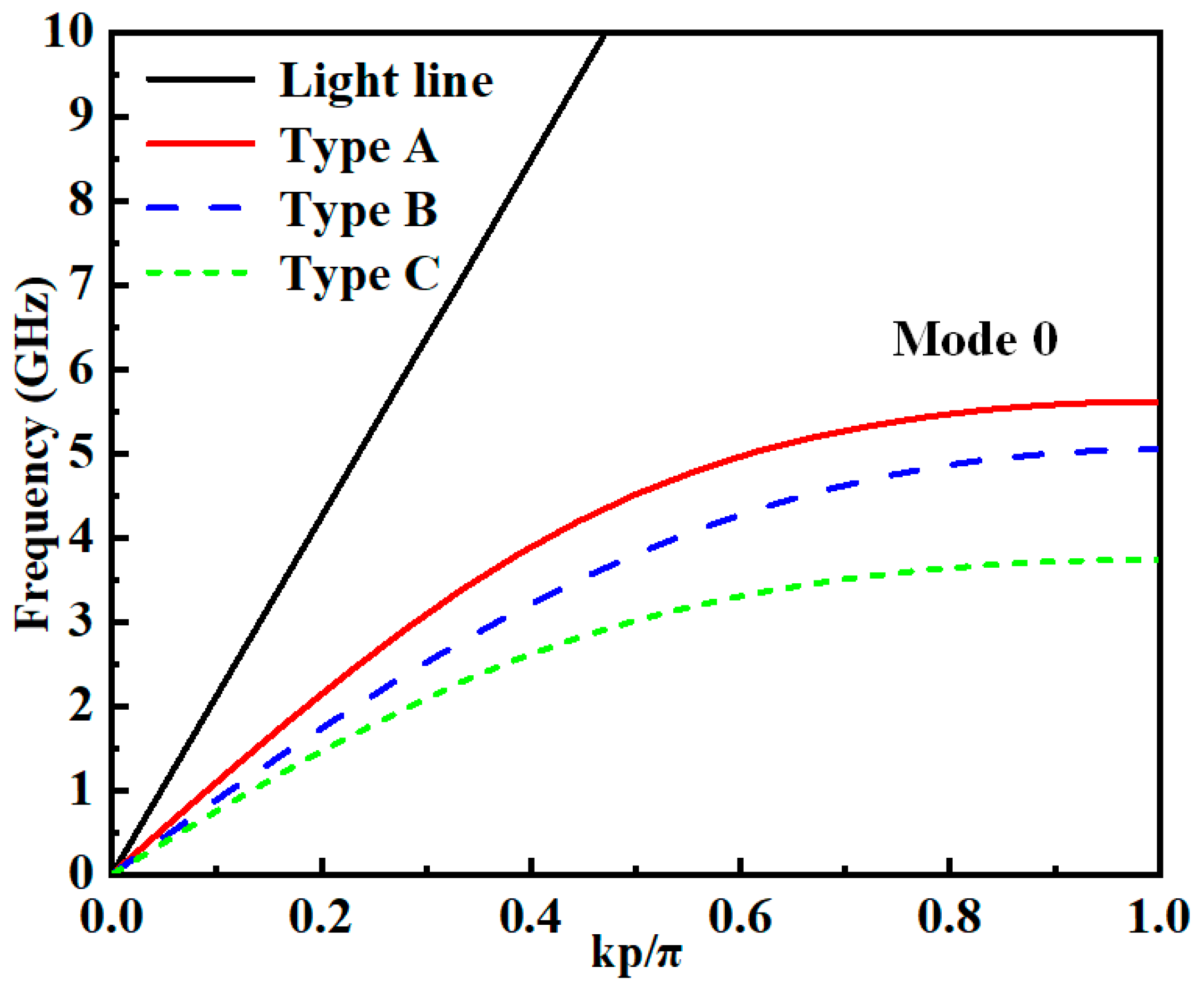

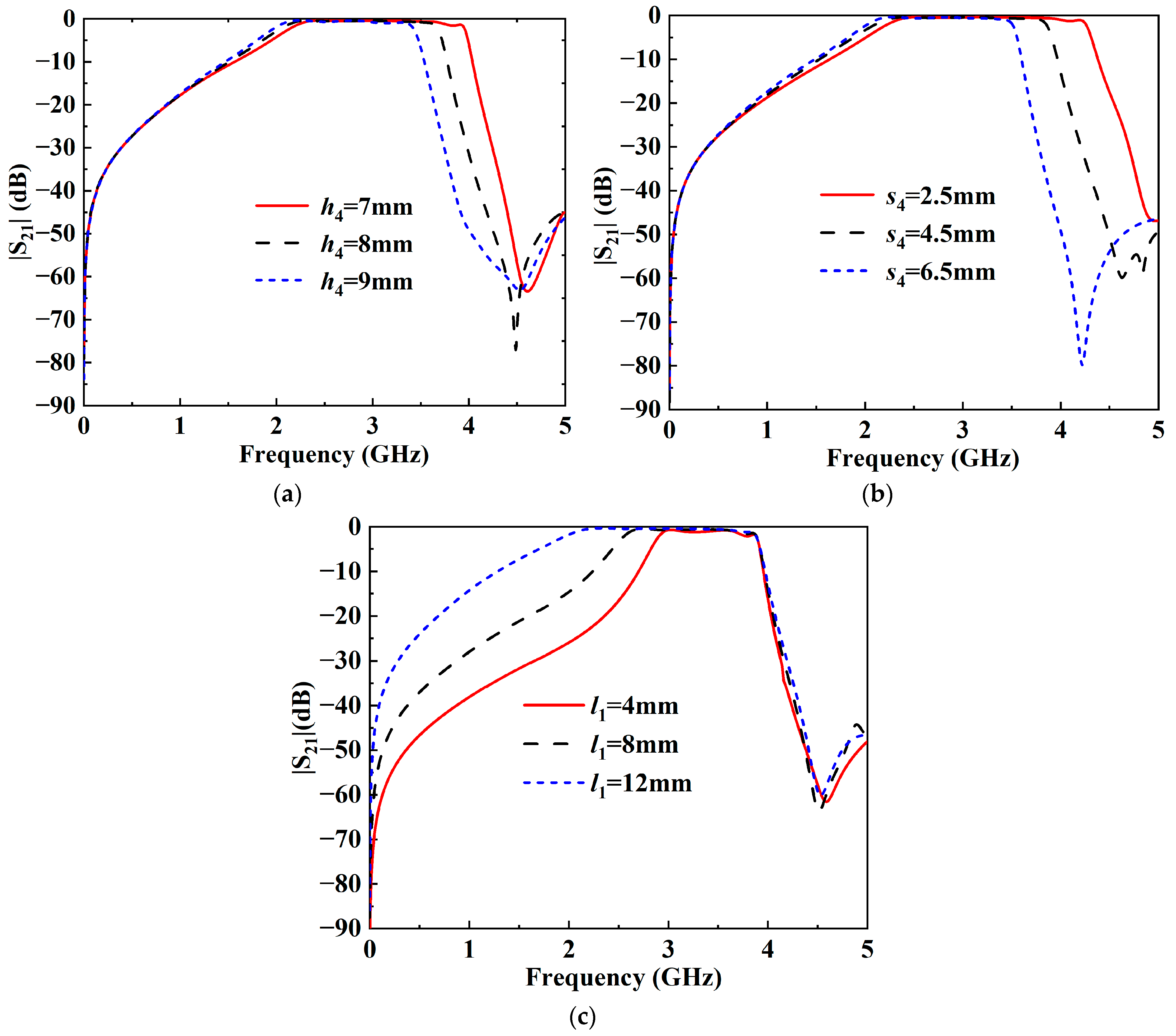
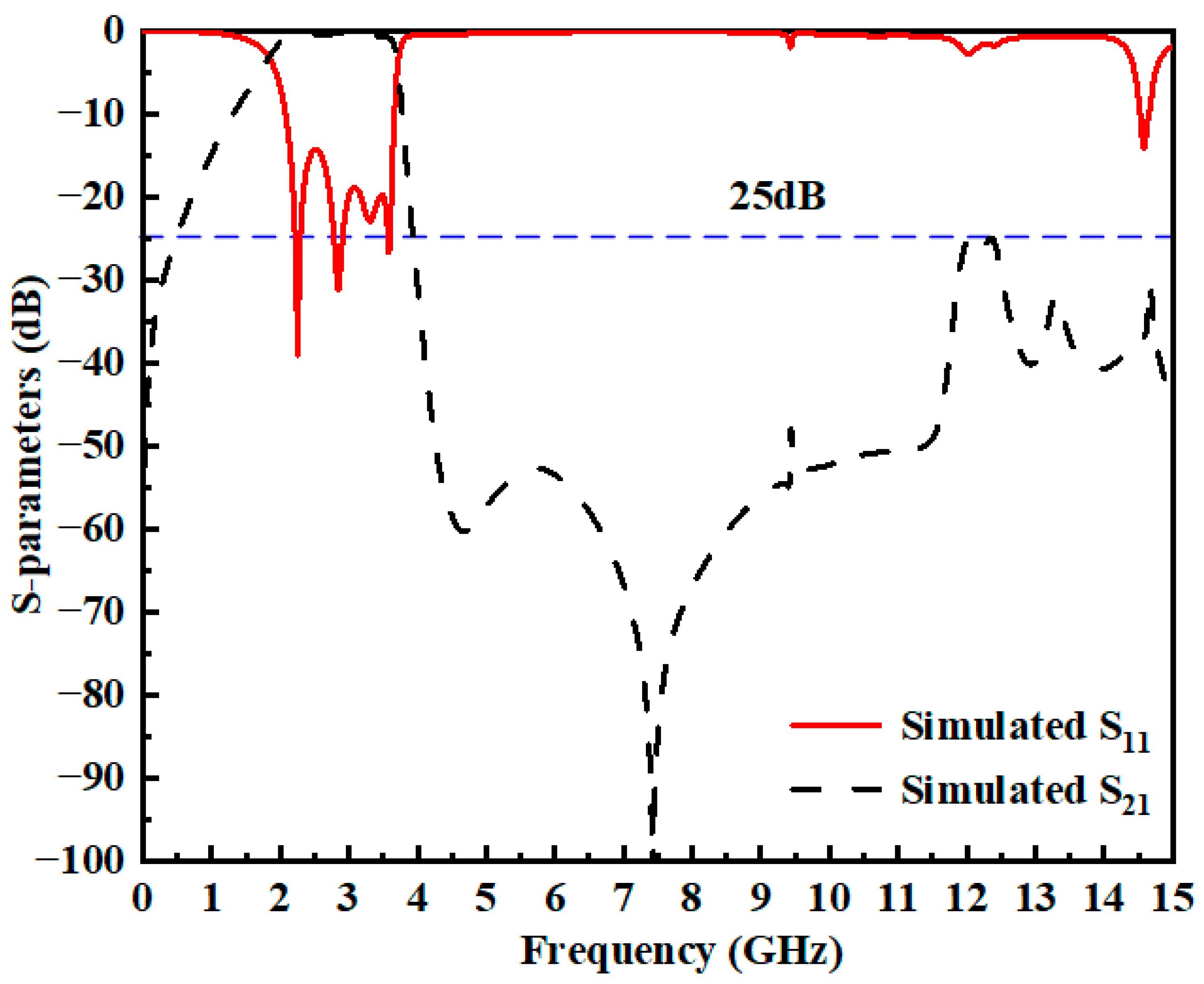
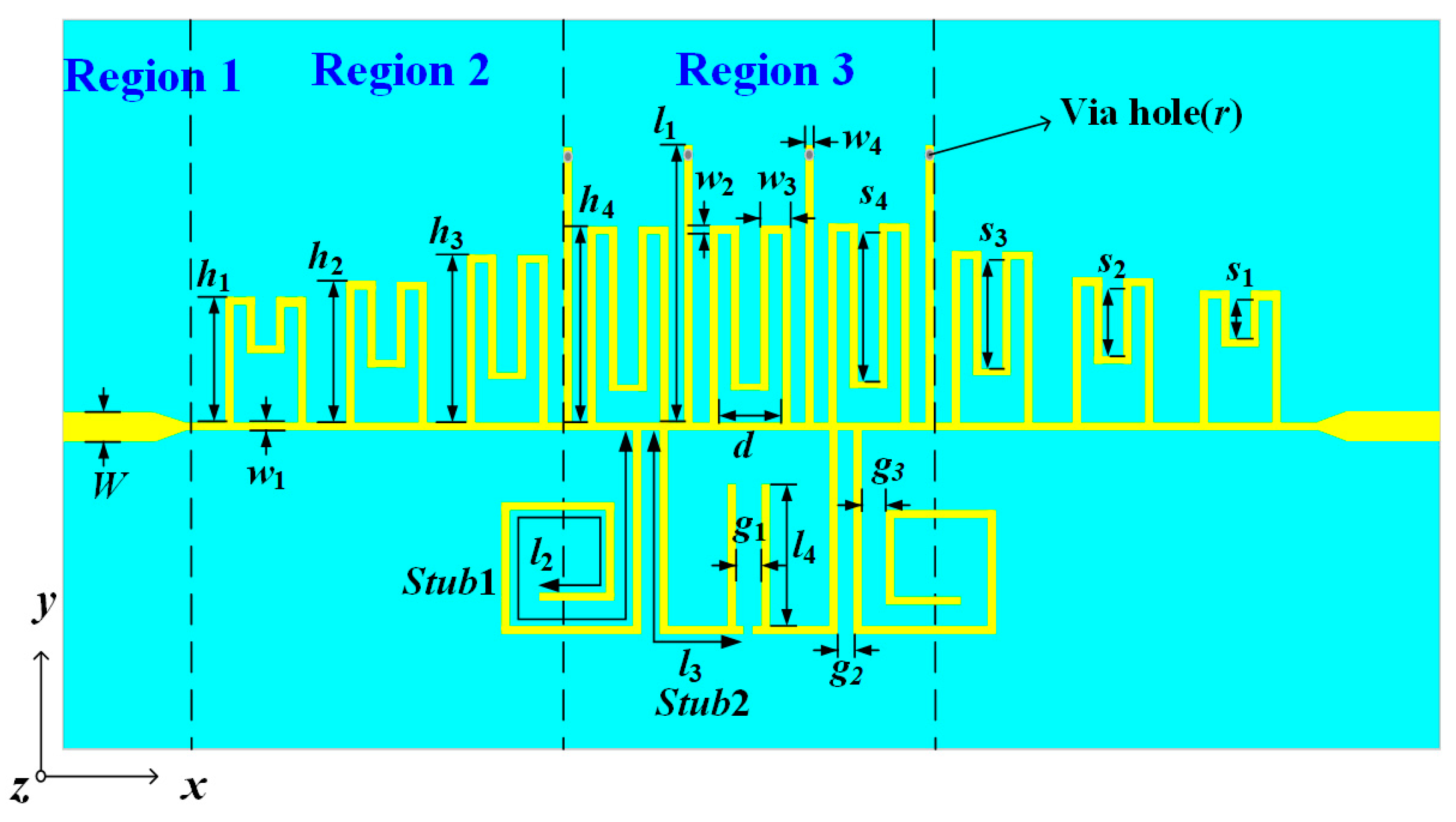

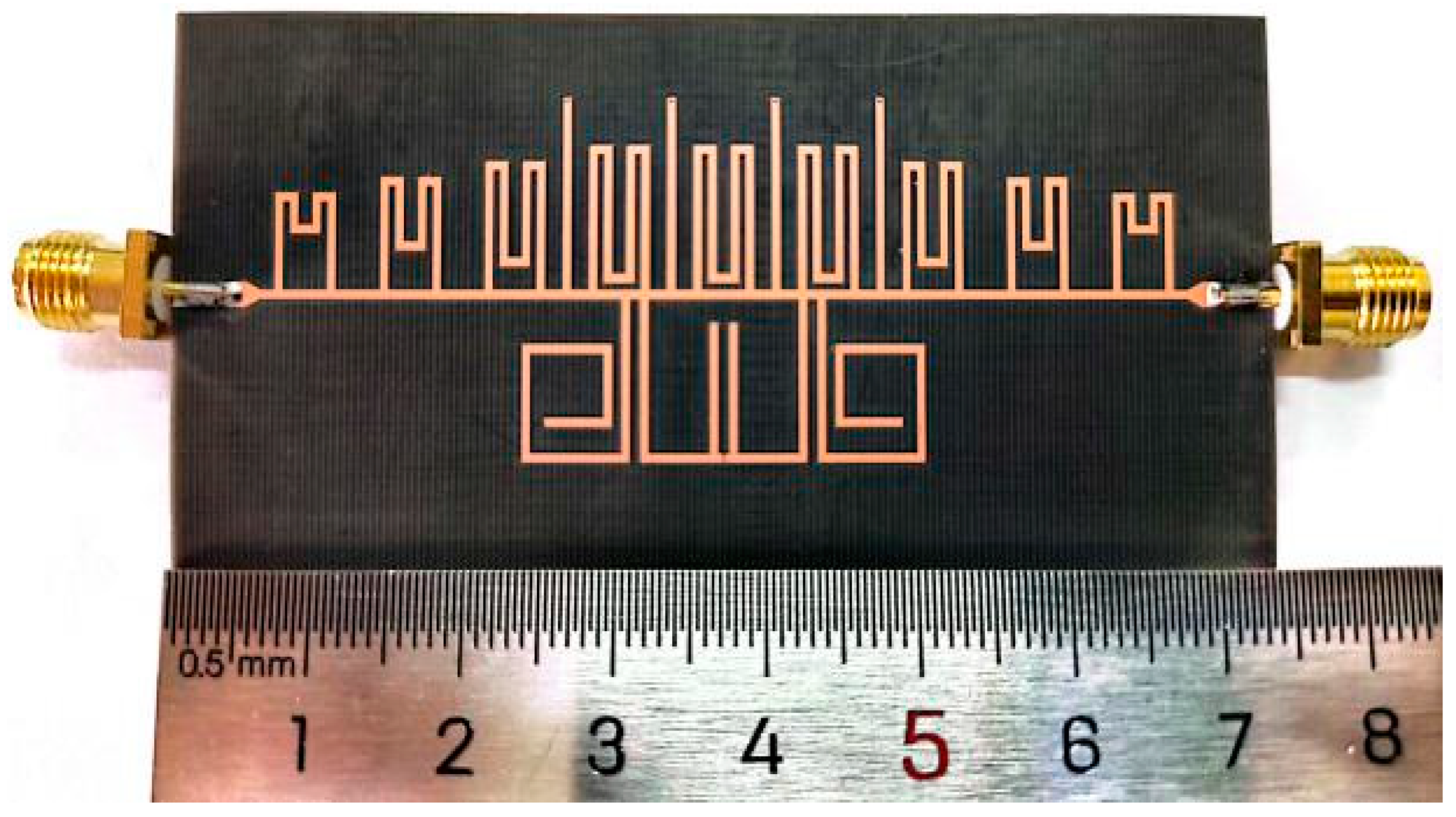

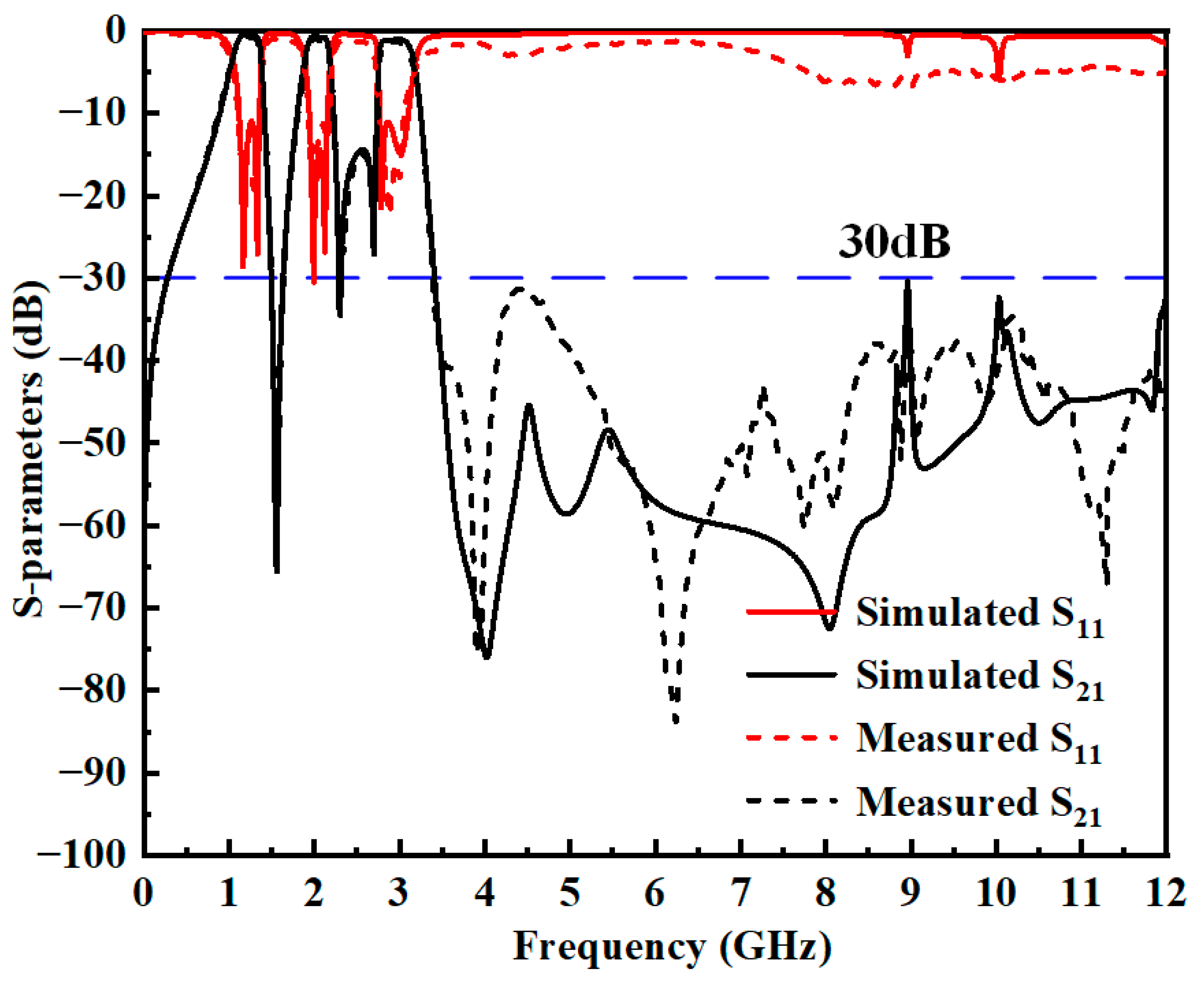
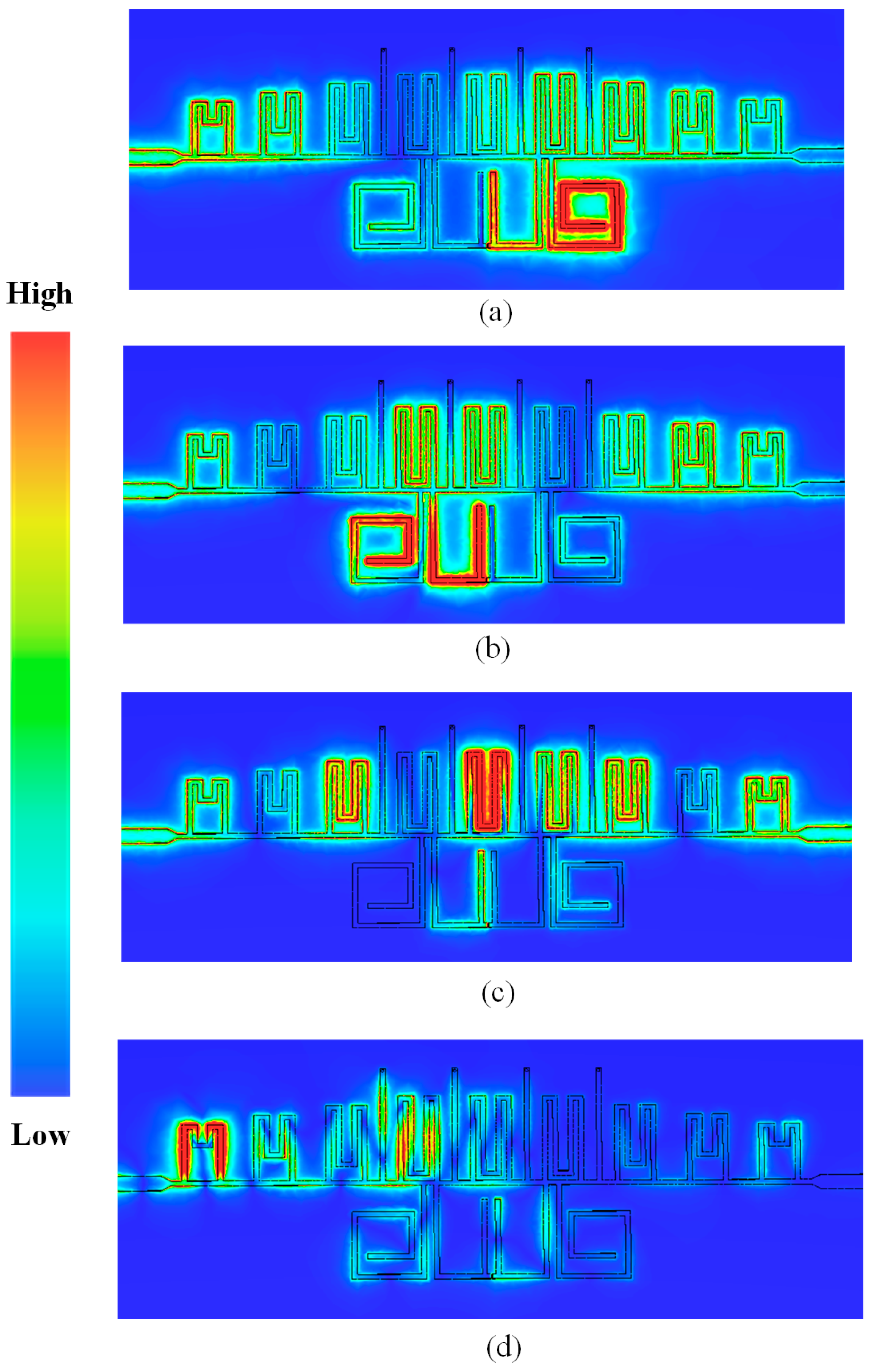
| Para. | Values | Para. | Values | Para. | Values |
|---|---|---|---|---|---|
| W | 1.54 | h2 | 6 | s4 | 5.5 |
| w1 | 0.5 | h3 | 7 | p | 7 |
| w2 | 0.5 | h4 | 8 | d | 3 |
| w3 | 1.5 | s1 | 2.5 | l1 | 12 |
| w4 | 0.5 | s2 | 3.5 | ||
| h1 | 5 | s3 | 4.5 |
| Para. | Values | Para. | Values | Para. | Values |
|---|---|---|---|---|---|
| W | 1.54 | h4 | 9 | l2 | 33 |
| w1 | 0.5 | s1 | 1.5 | l3 | 15 |
| w2 | 0.5 | s2 | 3.5 | l4 | 8 |
| w3 | 1.5 | s3 | 5.5 | g1 | 0.8 |
| w4 | 0.5 | s4 | 7.5 | g2 | 0.75 |
| h1 | 6 | p | 7 | g3 | 0.66 |
| h2 | 7 | d | 3 | ||
| h3 | 8 | l1 | 12 |
| Ref. | Central Frequency (GHz) | Circuit Size (λg2) | IL (dB) | Upper-Band Rejection (GHz) | Controlled Bandwidths | Type |
|---|---|---|---|---|---|---|
| [16] | 2.9, 5.6, 11 | 2.41 × 0.72 | 3, 3.1, 5.0 | 6.89f1 (>40 dB) | NO | SSPPs |
| [17] | 8, 10.02, 11.74 | 2.64 × 0.71 | 1, 1, 1 | N/A | NO | SSPPs-SIW |
| [18] | 4.6, 7.85, 12.45 | 1.05 × 0.24 | 0.5, 0.5, 0.7 | N/A | NO | SSPPs |
| This work | 1.2, 2.03, 2.96 | 0.38 × 0.13 | 0.56, 1.1, 1.2 | 10f1 (>30 dB) | YES | SSPPs |
Disclaimer/Publisher’s Note: The statements, opinions and data contained in all publications are solely those of the individual author(s) and contributor(s) and not of MDPI and/or the editor(s). MDPI and/or the editor(s) disclaim responsibility for any injury to people or property resulting from any ideas, methods, instructions or products referred to in the content. |
© 2025 by the authors. Licensee MDPI, Basel, Switzerland. This article is an open access article distributed under the terms and conditions of the Creative Commons Attribution (CC BY) license (https://creativecommons.org/licenses/by/4.0/).
Share and Cite
Ren, B.; Chen, W.; Zhang, X.; Guan, X.; Xu, K.-D. Compact Tri-Band Bandpass Filter with Wide Upper Stopband Based on Spoof Surface Plasmon Polaritons and Open-/Short-Circuited Stubs. Electronics 2025, 14, 285. https://doi.org/10.3390/electronics14020285
Ren B, Chen W, Zhang X, Guan X, Xu K-D. Compact Tri-Band Bandpass Filter with Wide Upper Stopband Based on Spoof Surface Plasmon Polaritons and Open-/Short-Circuited Stubs. Electronics. 2025; 14(2):285. https://doi.org/10.3390/electronics14020285
Chicago/Turabian StyleRen, Baoping, Wenjian Chen, Xiaoyan Zhang, Xuehui Guan, and Kai-Da Xu. 2025. "Compact Tri-Band Bandpass Filter with Wide Upper Stopband Based on Spoof Surface Plasmon Polaritons and Open-/Short-Circuited Stubs" Electronics 14, no. 2: 285. https://doi.org/10.3390/electronics14020285
APA StyleRen, B., Chen, W., Zhang, X., Guan, X., & Xu, K.-D. (2025). Compact Tri-Band Bandpass Filter with Wide Upper Stopband Based on Spoof Surface Plasmon Polaritons and Open-/Short-Circuited Stubs. Electronics, 14(2), 285. https://doi.org/10.3390/electronics14020285







